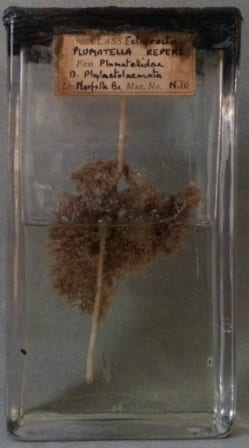Specimen of the Week: Week Eighty-Five
By Emma-Louise Nicholls, on 27 May 2013
 Whenever we have a school visit I tend to start with the question “What is Zoology?” Obviously, I put it in a way more thought-provoking and dynamic format than that. But it essentially comes down to comparing the Grant Museum with other types of museum in London to ascertain what you would find here. For example, as we are a zoology museum you wouldn’t (sadly) find a Spitfire Mk IX or an HMS this that or the other. Those are obvious examples, sometimes what causes a little debate is plants. They are living things, but do they belong in a museum of zoology? This week’s Specimen of the Week is…
Whenever we have a school visit I tend to start with the question “What is Zoology?” Obviously, I put it in a way more thought-provoking and dynamic format than that. But it essentially comes down to comparing the Grant Museum with other types of museum in London to ascertain what you would find here. For example, as we are a zoology museum you wouldn’t (sadly) find a Spitfire Mk IX or an HMS this that or the other. Those are obvious examples, sometimes what causes a little debate is plants. They are living things, but do they belong in a museum of zoology? This week’s Specimen of the Week is…
**The Bryozoa**
1) A WHAT?? Nooooo, it’s not a plant. We are a Museum of Zoology don’t you know. There aren’t any plants in here (except one or two thin sections that slipped through the screening process for the Micrarium. If you can find them in amongst the 2,321 other slides, I’ll give you, err… respect). Bryozoans may do a really good job of looking like small shrubs but they are in fact mind-blowingly interesting. Not that plants aren’t. Uh hum. Bryozoa are a type of aquatic invertebrate known as a sea matt, or a moss animal.
2) Nearly every species of bryozoan is colonial, which above and beyond having a good social life, means a single mass is made up of a number of individual organisms that number from a few, to a few million. That’s gregariousness for you. Each individual animal is called a zooid and has a miniscule ‘body’ length of less than a millimetre. The zooid sits within an individual sheath of tissue. In the centre of the animal is a single opening that contains a ring of ciliated tentacles protruding from it which serve to capture both food and errr… sperm. More on that later.
3) Despite their apparent simplicity, there are around 5000 species (yes, thousand) of bryozoan in the modern day. As incredible as that sounds, they also have an extensive fossil record of several times that number. An incredible feat of imagination and attention to detail must be required to be a researcher of bryozoans. All species of Bryozoa are aquatic and the vast majority inhabit salt water. The one featured here however, is a special freshwater species. There aren’t many freshwater bryozoans and all belong within a single group called the Phylactolaemata. Say that after a few pints.
4) The majority of species of bryozoa are encrusting and, normally, both sessile (attached to a substrate by their base) and immobile. They may seem like the same thing, unless you’ve heard of the walking palms of the Amazon. Encrusting species of Bryozoa attach themselves to hard substrates such as rocks, shells, wood, and algae. There are a also a small number of species that are able to colonise loose sediment. Despite an individual zooid reaching less than a millimeter in length, colonies range in size from a few millimeters to several meters.
5) All Bryozoa are primarily found in shallow water, though sporadic individual colonies have been found as deep as 8,200 m below sea-level. They are able to reproduce in both a sexual and an asexual manner. It’s not so much as a life choice, like joining a convent, but rather that they will do either as and when the situation calls for it. If a piece of the colony is broken off from the group, the piece will not die but continue to grow and eventually form a new colony. This is asexual reproduction. The majority of bryozoa are hermaphrodites (both ladies and gentlemen) and so release both sperm and eggs. The sexual variant of reproduction occurs through the expulsion of sperm into the water column which gets captured by other individuals using their tentacles. The sperm is then used to fertilise any eggs that each zooid is brooding internally.
Emma-Louise Nicholls is the Museum Assistant at the Grant Museum of Zoology
One Response to “Specimen of the Week: Week Eighty-Five”
- 1
 Close
Close




[…] From ‘Grant Museum of Zoology’, May 27, 2013 […]